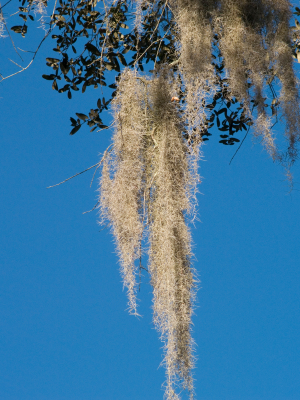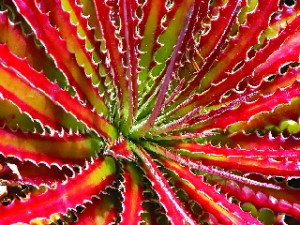Bromeliads of the United States
Author: Melanie DearringerNo Comments

All except one bromeliad species are native to the Americas. The bromeliad family’s natural range extends from southern United States to the Andes Mountains, rain forests and coasts of South America. Most bromeliads prefer tropical, humid climates, with tree canopies for cover. However, some are adapted to thrive in rocky and arid terrain.
The vast majority of bromeliads are native to Central America and down through southern portions of Brazil. However, there are quite a few species that are native to the southern continental United States. These bromeliads primarily occur in Florida, but can extend as far north as Virginia and west as far as Arizona.
Florida’s Bromeliads

Spanish Moss is another bromeliad in Florida and Texas.
Florida has the largest collection of native bromeliads with sixteen native species. Most are found in the Tillandsia genus, but there are a few Catopsis and one Guzmania as well. Ten of the sixteen species are consider threatened or endangered due to loss of habitat and destruction from the Mexican Bromeliad Weevil. Bromeliad enthusiasts in Florida are working hard to fight the loss of these fragile bromeliads. Many enthusiasts are working to collect seeds so that the diversity of bromeliads in Florida can be maintained.
Tillandsias
The most common bromeliad found in the continental United States is Tillandsia usneoides, better known as Spanish moss. Spanish moss clings to trees and even telephone poles in huge masses throughout the southeastern United States. It is a small air plant that uses special scales called trichomes to absorb water and nutrients from the air. While each individual plant is small they reproduce rapidly to create thick mats that drip and hang from other substrates such as oaks. It thrives in the warm and humid environment found in the South. Spanish moss does not typically harm its substrates. However the thick mats can become quite heavy and may occasionally cause limbs to break.
Another common bromeliad found in the United States is Tillandsia recurvata or ball moss. Ball moss can be found in Georgia and extends west into Texas. Like Spanish moss, ball moss grows on substrates. It is commonly found on Southern Live Oaks. Instead of dripping or hanging like Spanish moss, true to its name, ball moss forms tight balls. These clumps range in size from golf ball sized to soccer ball sized.
Tillandsia setacea is also called southern needleleaf. It is common in Florida and Georgia. It is an air plant that grows in clumps in hammocks and swamps. Like its common name suggests it looks like a clump of pine needles. The leaves are slender and grow up to a foot long. They are usually green but will tinge red when exposed to bright sunlight. They produce a six inch flower stalk with small violet flowers. The southern needleleaf thrives easily in the warm, humid climates that most of Florida has to offer.
Catopsis
While many of the bromeliads native to the United States are Tillandsias, there are a few Catopsis native to Florida as well.
Catopsis berteroniana is a unique species of Catopsis whose northern most range is in Florida, but it extends south to southern Brazil. It is unique because it is the only Catopsis that is considered carnivorous. Its leaves come together to form a tall upright vase. The vase traps insects inside and the water held inside the vase breaks down the insects so the plant can use it for nutrients. This species is epiphytic, but is unique because it likes to grow on the tops of trees where is gets plenty of direct sunlight rather than under the canopies like most other epiphytes. They can be found in the Everglades National Park basking in the sun on the tops of the canopies.
The Catopsis floribunda, also known as the Florida strap airplant, is one of the threatened species found in Florida. It is a bright green epiphyte that can grow up to 28 inches tall. It prefers humid shady spaces such as cypress swamps. Unfortunately, it is particularly susceptible to the Mexican bromeliad weevil which is devastating its populations in southern Florida.
Catopsis nutans is a bit smaller than the Florida strap airplant growing only twelve inches tall. It prefers similar shaded, humid habitats where it grows attached to trees. It has glossy green leaves and produces small orange flowers. Like the Florida strap airplant, Catopsis nutans is also endangered due to the Mexican bromeliad weevil and the significant loss of habitat.
There is also a single Guzmania species native to Florida. Guzmania monostachia is also called the West Indian tufted airplant. This plant is an epiphyte that can also grow terrestrially. The plant grows about ten inches high and produces white flowers on a tall pink flower spike. It also prefers humid sloughs and cypress swamps. The West Indian tufted airplant is threatened by illegal collection and the Mexican bromeliad weevil. It is not easily found in nature, but where it does exist it is usually found in large colonies.
Texas’ Bromeliads
In addition to ball moss and spanish moss and one other Tillandsia, Texas also boasts another genus of bromeliad not found in Florida. The genus Hechtia is specially adapted to thrive in the arid climates and rocky environments that are common in portions of Texas.
Hechtia
Unlike Tillandsias, Hechtia texensis is a terrestrial plant. It likes to grow in rocky, arid soils. It thrives in partial shade to full sun. The plant is native to the southwestern part of Texas and the northern Mexican deserts. It has glossy leaves that are bright green, but turn red towards the margins. It also has sharp white spines around the leaf margins. Hechtia texensis produces a two foot flower stalk with white flowers. The plant is hardy down to 20 degrees. This plant can be grown as a very beautiful container plant.
Hechtia glomerata is also known as guapilla. Like Hechtia texensis it is native to the arid regions of southern Texas. It prefers to grow on rocky outcroppings. The plant has long, slender green leaves that have silvery scales on the undersides. They also have sharp spines all the way around the margins. They pup generously to form large masses of plants. Each plant can produce a tall flower stalk that rises above the rosette. This plant can thrive in dry, sunny conditions and can tolerate temperatures down to 18 degrees.
Enjoy Diverse Bromeliads
These are some of the bromeliads native to the United States. Some are best enjoyed in their native landscapes, while others such as the Hechtia species can make attractive container plants in cultivation. Most bromeliads can be only be found south of the United States in more tropical climates. However, if you are from the United States, you don’t have to travel too far to appreciate the many bromeliads of the United States and the unique environments to which they are adapted. What bromeliads have you seen in their native landscape?
Sources
“Tillandsia recurvata.” Wikipedia. <https://en.wikipedia.org/wiki/Tillandsia_recurvata>
“Catopsis berteroniana” Wikipedia. <http://en.wikipedia.org/wiki/Catopsis_berteroniana>
“Florida’s Native Bromeliads.” University of Florida IFAS Extension.<https://edis.ifas.ufl.edu/publication/uw205>
“Hechtia texensis.” Strange Wonderful Things. <http://www.strangewonderfulthings.com/234.htm>
“Native Plant Database.” The University of Texas at Austin. <http://www.wildflower.org/plants/result.php?id_plant=HEGL7>
“Save Florida’s Native Bromeliads.” University of Florida. <http://entnemdept.ufl.edu/frank/savebromeliads/setacea.htm>

Resource Download
Hechtia Care Cheat Sheet
Learn how to care for your Hechtia bromeliad with this quick and easy informational guide.
Learn More
Ask an Expert
Questions about bromeliads?
Our experts love a challenge!
Photo of the Week
Submit your photo to be featured on the blog!
More Photo of the Week Winners
Submit Photo








